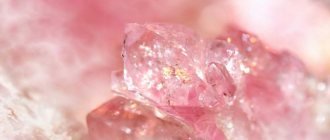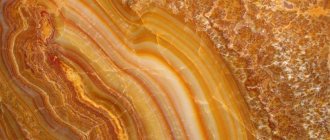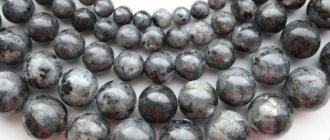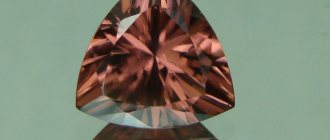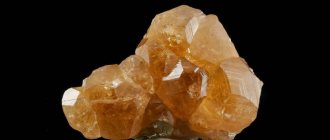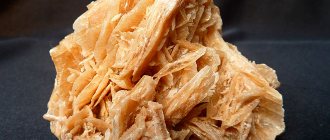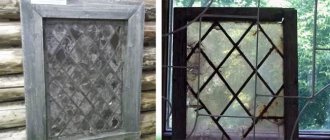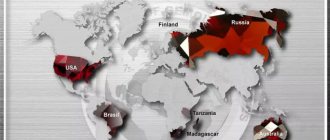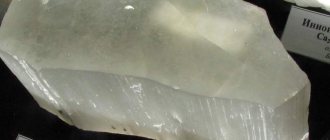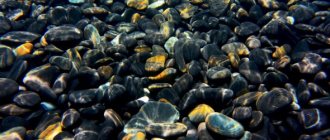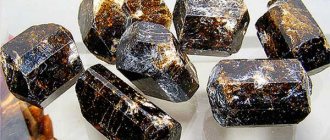Natural formations encountered in everyday life often do not attract much attention. Rocks used in industry, medicine and other industries are rarely appreciated as containing miraculous energy.
Orthoclase is a love amulet; it is one of the “hard worker” minerals, irreplaceable in various spheres of life.
Description of the stone and its origin
Orthoclase is classified as a potassium feldspar. More often it is contained in acidic or moderately acidic igneous or metamorphic rocks. The stone is often adjacent to albite, quartz, and mica. In igneous rocks it is also found together with hornblende, and in pegmatite veins with beryl.
Orthoclases are available in different sizes. These can be either small microliths or large stones several meters wide.
Orthoclase has been known to people for several millennia, but it received a scientific description only in 1823 thanks to the scientist August Breithaupt. He also gave the name to the mineral, which comes from the Greek language. The words "orthos" and "clasus" mean "straight" and "crack". This name is due to the right angle between the cleavage planes - the stone splits into rectangular fragments.
What is
Orthoclase is a type of feldspar, the most common stone on the planet.
Rock-forming mineral of nepheline syenites, hornfels, pegmatite veins.
It has different, but not flashy, shades and degrees of transparency.
Samples with fluorescence – bluish or orange – are especially valued. This is how faceted orthoclase shimmers in the sun or in the light of the full moon.
Main deposits
Orthoclase is found on all continents except Antarctica. There are many deposits:
- Australia;
- Austria;
- Asia - in jewelry they mainly use stone from India, Myanmar, and Sri Lanka.
- Brazil;
- Germany is the territory of the former Federal Republic of Germany;
- Zimbabwe - mining of blue-green mineral;
- Italy;
- Kyrgyzstan (Pamir);
- Madagascar – transparent yellowish stones are mined here, which are especially valuable in jewelry;
- Mexico;
- Russia – Transbaikalia, Kola Peninsula, Ural (Cherry Mountains, Ilmenskoye field), Khabarovsk Territory;
- USA;
- Czech Republic.
Works with the power of magic
Nobody knows how orthoclase helps in matters of the heart. But this help is always tangible. A stone given to newlyweds will retain its color as long as the marital relationship lasts. Its color will change if the marriage is in danger of destruction...
The mineral cannot be used as a love spell. Any love spell is a deception, but orthoclase protects you from deception. He knows how to generate love, plant the seed of feeling in a person’s soul!
Varieties
Orthoclase is divided by appearance. The most popular moonstone (adularia) is bluish in color. It has the most pure composition. Specimens of a soft silver hue mined in Sri Lanka are especially prized.
In moonstone, orthoclase alternates layers with albite, providing the characteristic effect of this variety. The mineral can be slightly transparent or semi-translucent. For this type, the cabochon-dome cut is preferred. Sometimes there is a cat's eye effect.
Helpful information
Adularia gets its name from the Italian Adula Mountains, where it was first discovered. It is also mined in Switzerland (Alps). It is also called ice spar.
A yellow or reddish colored variety of orthoclase is called sunstone. The cut gives it a golden shine. There are many deposits, but especially large specimens are found in Madagascar - the weight after cutting exceeds 100 carats. The reddish mineral is also called erythritol, and the yellow one is ferriorthoclase.
Another type of orthoclase is sanidine. This is the name given to stones of glassy gray or beige color. They are mined mainly in the USA and Germany. This type of mineral is characterized by inclusions of tabular crystals.
Greenish orthoclase is called lennilite.
Orthoclase can have an iridescence effect, when in bright light a rainbow-colored glow is visible on an even chip. Specimens with a pearly-grayish glow are called wolf's eye. The effect is especially pronounced after polishing.
Buy inexpensively?
Buying orthoclase – regardless of price – is not always easy. Jewelry-quality stones are mined only on the outskirts of Hindustan, and enter the domestic market sporadically. For a ten-carat stone of average quality they can ask for $300.
Lemon-yellow orthoclase, cut according to strict classical patterns, can cost $100 per unit weight. For high-quality calibrated round-shaped cabochons with a diameter of 4-5 mm, they will ask for 15-25 dollars per carat.
Physicochemical characteristics
The chemical formula of orthoclase is K(AlSi₃O₈). Almost 65% of the mineral consists of silicon dioxide. It also contains other elements:
- aluminum oxide (18.5%);
- potassium oxide (17%);
- sodium oxide;
- isomorphic impurities - possible presence of aluminum, barium, iron, calcium, rubidium.
The appearance of orthoclase crystals can be tabular, columnar, or prismatic. The mineral has the following physical qualities:
- hardness 6-6.5 on the Mohs scale;
- density 2.56 g/cm3;
- refraction 1.52;
- the luster is glassy, but untreated specimens do not shine;
- the coloring is usually uneven, spotted;
- stones are often opaque; a translucent mineral with transparent parts is rare;
- in ultraviolet light it is pale blue or orange luminescence, in x-rays it is white or violet;
- monoclinic system;
- the fracture is stepped or uneven;
- fragility;
- difficult to fuse;
- solubility in nitric acid, decomposition in fluoric acid;
- low optical relief;
- cleavage perfect in one direction and average in the other, the angle between its planes is straight.
How to care
Orthoclase is not particularly hard (6 Mohs points) and is fragile. These properties of the stone are taken into account when used.
It is easy to care for:
- Protect from falls and impacts.
- A durable, opaque packaging/display case is suitable for storing jewelry and collection material.
- Do not leave products near heat sources.
Dirt is removed with warm water and soap and immediately wiped dry. Cleaning with ultrasound is prohibited: the sample will crack.
Magic properties
Orthoclase is endowed with mystical powers:
- protection of the family hearth, marriage;
- suppression of groundless jealousy;
- mood lifting;
- neutralization of a violent emotional outburst, a depressive state;
- awakening of love - the stone cannot be used for a love spell, but it helps to determine your feelings;
- activation of creative potential;
- assistance in making a better decision, concentration - orthoclase should be used if you are excessively absent-minded or daydreaming;
- attracting useful people;
- protection from black magic.
Orthoclase is a good gift for a wedding. It should be placed in a prominent place in the house. As long as the shine of the stone remains, the atmosphere in the family is favorable. Cloudiness of a transparent mineral, a change in its color or the appearance of cracks warns of impending trials.
One of the magical properties of orthoclase is the absorption of positive energy. This allows him to help his owner on bad days.
Therapeutic effect
Centuries-old practice has revealed and confirmed the healing properties of orthoclase:
- Its main mission is to preserve mental health. A transparent mineral can bring you out of the depths of black melancholy, depression, and reduce the degree of aggression or irritability. With him, a person will again feel a taste for life.
Orthoclase protects against impulsive actions, therefore it is recommended as a companion for people prone to aggression or suicide.
- This is a powerful palliative for oncology. The mineral itself will not stop it, but it increases the effectiveness of traditional medications. In addition, it neutralizes their toxicity, which allows you to increase the dose of the drug.
Along the way, the healing stone strengthens the immune system, supporting the health of the body as a whole.
Areas of use
Orthoclase is used in various fields. The mineral is not very popular in jewelry. Spectacular moon or sun stones are more commonly used in this area. Pure specimens of rare quality and brilliant shine are prized.
Orthoclase is applicable in the following areas:
- production of certain types of glass, ceramics, glaze, enamel, porcelain, earthenware;
- production of electrical insulators;
- component of mineral mixtures, material for prosthetics in dentistry;
- use in construction for cladding.
Orthoclase is also used for crafts. It makes attractive figures.
Where is the mineral used?
Areas of application of orthoclase are industry, jewelry, arts and crafts.
Industry
The mineral rock has found application in the production of various products:
- This is a popular and aesthetic finishing building material.
- Orthoclase makes the best electrical insulators.
- It is a component of mixtures used by dentists.
- It is used in the manufacture of porcelain and earthenware products, glazes, and enamels. It is the main component of high quality glass and ceramics.
The last area of use is perhaps the most important of the “practical” ones. The importance of stone as a source for producing glass and porcelain was understood by the inhabitants of the Celestial Empire, who are considered their inventors.
Jewelry
Jewelers almost always create jewelry with orthoclase, in which it appears as a cabochon insert (rings, rings, earrings, pendants).
The lunar and solar varieties are especially popular: the processed stones sparkle in the sun. Products with them are suitable for people of all ages and for any occasion.
Other areas
The low density made the stone easy to process. Products made from orthoclase - figurines, balls, pyramids, keychains - look unique. Therefore, sellers do not have them lying around.
Unusual specimens are the object of hunting for collectors of mineralogical collections. Often such specimens are several times more expensive than jewelry material.
Jewelry with stone
Sun or moon stones are more often used for jewelry, since processed stones look most attractive among other varieties of the mineral. The preferred cut is cabochon.
Orthoclase is used as an insert in rings, pendants, and earrings. The mineral is usually given the correct shape, but sometimes it is left in its natural form, limited to polishing or without it.
Frames for orthoclase are often made of silver or alloys of this color. Sometimes I use gilding, and even less often gold.
Beads and bracelets are made from orthoclase. Such products with this mineral are less popular.
Price
The cost of orthoclase depends on the size, color and quality of the stone. The price of jewelry is influenced by the frame material, manufacturer, uniqueness of the product and other factors.
The average cost of 10 carat orthoclase is $300. For a yellow specimen with a high-quality cut, you should pay about $110. The stones in the photo from Afghanistan with an average weight of 2.5 carats (diameter 8 mm) are jewelry inserts and cost about 3 thousand rubles per carat.
A ring with a moonstone in silver can be bought from 1,300 rubles.
Who is suitable according to their zodiac sign?
According to the horoscope, orthoclase (except for its variety heliolite) is suitable for Cancer and Pisces . These zodiac signs have full compatibility with the stone, so it will provide support in everything. Help in creative activity, developing intuition, and achieving mental balance will be especially noticeable.
An orthoclase talisman helps only people who are not inclined to harm others and are not committed to black magic.
Astrologers do not recommend wearing orthoclase to the zodiac signs of the element of Fire (Aries, Leo, Sagittarius), as it can cause melancholy and pessimism. But according to the horoscope, these signs are fully compatible with heliolite. For people born under the constellations Aries, Leo and Sagittarius, spinel and ruby are perfect. In addition, amber is also a lucky stone for Sagittarius and Leo.
Also suitable according to the horoscope:
- For Sagittarius - lapis lazuli, ulexite, chalcedony, blue sapphire, blue quartz.
- For Leo - diamond, rock crystal, golden quartz, chrysoberyl, black diamond.
- For Aries - creole, emerald, tanzanite.
Briefly about orthoclase
The mineral orthoclase has been known to man for many thousands of years. However, it was only at the beginning of the 19th century that it was described in detail and given a name by the famous mineralogist August Breithaupt.
The name comes from the type of its structure: “orthos” - straight, “clasus” - crack (translated from other Greek). Due to the fact that the planes of the gem are welded together at an angle of 900, orthoclase consists of small rectangles.
The quartz-orthoclase combination gives rise to “written granite” (Jewish stone).
In real orthoclase you can always notice small flaws: inclusions, cracks and bubbles, which are especially noticeable in sunlight. The fake stone has no defects.
Features of care
Due to its increased fragility, orthoclase should be protected from mechanical stress. It is recommended to store it separately from other minerals, using for this purpose a box or case with a soft interior.
Direct sunlight, hot air and detergents containing acids have a destructive effect on the structure of this mineral. To clean the stone from dirt, you should use running water and baby soap. After washing, orthoclase must be dried naturally at room temperature or gently blotted with a flannel napkin.
